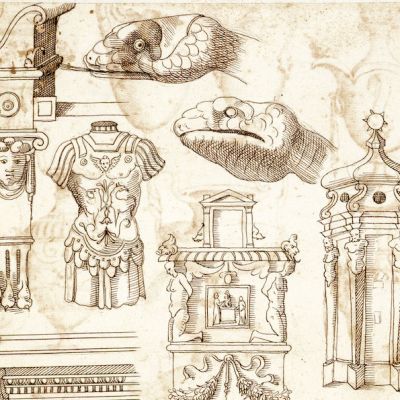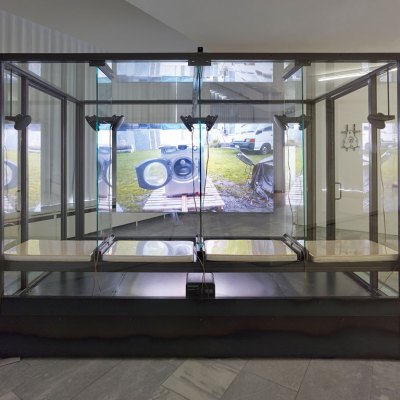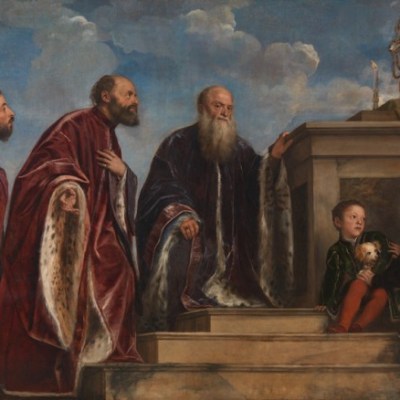The French fashion designer Hubert de Givenchy has died at the age of 91. One of the most acclaimed couturiers of the 20th century, Givenchy also amassed a diverse collection of art, spanning painting, sculpture and decorative art. In 2012, Susan Moore visited the couturier’s home in Paris, an elegant hôtel particulier built for a marquise in 1731, to talk about how he tailored his art collection to this environment. An edited version of the interview is republished below.
It seems entirely appropriate that Hubert de Givenchy should live in one of the most soberly perfect aristocratic hôtel particuliers in Paris. The Hôtel d’Orrouer, designed in 1731 by the architect Pierre Boscry for Marguerite-Paule de Grivel d’Orrouer, marquise de Feuquières, stands secreted behind a vast stone wall on the rue de Grenelle. When one of the great wooden doors of its triumphal arch of a porte-cochère opens, it reveals a courtyard of gravel and box, plus two classical golden-stone façades of such pared-down simplicity that they verge on the austere. It is a description that might equally fit the exquisitely tailored and infinitely flattering ‘clothes without ornament’ that the couturier – born Count Hubert James Marcel Taffin de Givenchy in 1927 – designed for his great muse, Audrey Hepburn.
Once inside the hôtel, it is clear that the same elegant aesthetic is at work. There is opulence and luxury in terms of materials – ormolu-mounted or gilded furniture, mirrors, candelabra, hardstone vessels, mirror-black vases and bronzes, plus rich embroideries and carpets – and a profusion of objects, but there is a rigour and symmetry in their arrangement that ensures an effect that is masculine and surprisingly unfussy. Nothing is extraneous. As his great mentor Cristóbal Balenciaga once said: the secret of elegance is elimination.
Givenchy has always seen the furnishing and decoration of his various apartments as an extension of his work as a designer. ‘What I try to achieve is principally a harmony between architecture, decoration and colour,’ he explains, as we sit at his desk overlooking a manicured garden. He offers me a choice of tea, coffee, water, Coca-Cola or Champagne, duly delivered by a white-coated butler. ‘This house already has a marvellous decoration of its own with the gilded boiseries of Nicolas Pineau, so I did not need to “decorate” very much. But I do try to find associations between objects in a way that looks natural. I am not interested in creating something that people say is different or amusing.’
Moreover, he looks appalled – in so far as his impeccable manners allow – when I refer to him as a collector. ‘Madame, I am not a collector,’ he insists. ‘I think of collectors as people who acquire a repetition of the same things – little boxes, or spoons. I have no desire to accumulate.’ He does, however, concede that collecting is in his genes. Three generations of his maternal family who owned or worked for the Gobelins and Beauvais tapestry manufactories made and sold various art collections. So, who or what influenced him?
‘I learned from the people I met over the course of my career, many of whom were collectors,’ he explains. ‘When I was very young, I chose to be a dress designer. My mother was wonderful about it, although she said it was not the kind of thing your father had in mind for you – he died when I was two years old.’ It began when Givenchy started work with Jacques Fath – he was 17 – and he had the opportunity to meet Marie-Laure de Noailles. The recklessly eclectic salon of the iconoclastic vicomtesse de Noailles was remarkable in combining the spare minimalist interiors and furniture of Jean-Michel Frank with great Old Masters and Schatzkammer silver-gilt, as well as the work of her Surrealist protégés. It was to exert a profound influence on the taste of Yves Saint Laurent and Pierre Bergé, among many others.
‘At that time, Paris was a dream,’ Givenchy continues. ‘You had Antenor Patiño, you had Arturo Lopez-Wilshaw and Charles de Bestegui.’ (The latter’s Château de Groussay has been described as having the greatest private interiors concocted in the 20th century.) ‘Of course, at the beginning I was not received by these people but, little by little, I was introduced to them, and many were very kind when they heard I was interested in furniture and invited me to visit. Of course, I looked and I looked, and I saw every style and tradition, and I realised what I did not like and what I did like.’ He pauses: ‘And this is my education – and what an education! Those people really understood French 17th- and 18th-century decorative arts and had a real understanding of quality and beauty.’
At the same time, he also began to haunt the premises of the Parisian antiques trade. ‘In the beginning I was scared to open the doors because I had no money to spend, but I went anyway. I remember often going to the Galerie Ramsey, the great antiquaires on the rue du Faubourg Saint-Honoré, and Mr Hammel was very nice to this tall young man who never bought anything. He would spend time telling me everything about a particular chair, [or] a style. I would visit Etienne Levy, Maurice Segoura, Jean-Paul Fabre and Didier Aaron. I would ask questions, and I began to understand more and more, and the more I learned, the more interested I became.’ He would also mark up auction catalogues and dream.
His salary was very small when he began with Fath but it improved as he progressed to Robert Piguet, Lucien Lelong and, finally, the eccentric Elsa Schiaparelli. In 1952 he opened his own design house, and had more time – and funds. ‘When at last I had the opportunity to buy a beautiful object, I bought a chair – a giltwood Louis XVI bergère. It is not, of course, the most important thing that I own but I will never sell it,’ he declares passionately.
While his fellow designers wanted to furnish their apartments immediately (Christian Dior, for instance, had a penchant for Napoleon III papier mâché: ‘I never liked that epoch, for me it is sad’), Givenchy understood almost from the start the importance of working slowly and buying the highest quality objects he could afford. He also never asked any expert for advice. ‘Little by little, I pursued my dream of acquiring furniture from the 17th and 18th centuries, and contemporary art.”
At this time, he also started travelling regularly to the US. His new clientele included the likes of Mrs Charles Wrightsman and Mrs Paul Mellon, and his art education continued apace through his access to these grandest of American collections. It was through an American in Paris, Bettina Shaw-Jones, Schiaparelli’s assistant and subsequently Mrs Gaston Bergery, that he met the ‘most important collector and decorator I had ever known in Paris’. This was the extraordinary Misia Sert […]. An arbiter of taste and fashion, she bought together the artistic and musical elite of Paris. After the death in 1945 of her estranged third husband, the Catalan painter José María Sert, she inherited his apartment on the rue de Rivoli with all of its contents. It was here that Givenchy visited the by now very frail and blind Misia.
‘Her apartment was like an Ali Baba’s cave,’ he recalls, ‘and it was incredible. The taste of her close friend Coco Chanel was in fact the taste of Misia – rock crystal, coromandel, gilt bronze and Boulle…and there was a particular Boulle armoire…’ After Misia’s death in 1950, Sert’s former secretary, the journalist Boulos (Pierre Ristelhueber), contacted Givenchy to ask him if he knew anyone who might buy the armoire as no one seemed to be in the least bit interested in Boulle. ‘On the front of the armoire was a chariot of Apollo and the bronze was of extraordinary quality – I would dream in front of that bronze,’ sighs Givenchy.
He asked around, offering the piece to Helena Rubenstein, the Princesse Gourielli. ‘One day, Boulos said: “Every time you visit you touch the armoire and caress the horses. Why don’t you buy it?” I said the price is impossible and I have nothing like it! In fact, when he told me the price I was so surprised that I said yes.’ The armoire spent 18 months at the restorer’s, which gave Givenchy the chance to completely rethink his apartment on the Esplanade des Invalides, in effect just one big room.
While most collectors of French decorative arts might aspire to graduate towards owning a single piece by the greatest and most influential of all French cabinetmakers, Givenchy all but began his collecting career with one. But displaying it became the next issue. ‘Apart from a few good chairs, all I had was a Rothko and a Miró, and they had nothing to do with a Boulle armoire. So I asked Charles Sevigny, an extraordinary young architect with great taste, if he could help. I asked him to make an enormous screen made of bronze-tinted mirror, and put the armoire directly in front of that. The combination of Rothko, Miró and Boulle was wonderful.’ His second Boulle acquisition for the small apartment was the hardly less remarkable six-legged bureau plat known as the Ashburnham desk, previously owned by Antenor Patiño.
And the Rothko? ‘One day Mrs Mellon sent me a postcard of a marvellous Rothko painting from the collection of the architect Philip Johnson. I said that I thought he was a great painter, and that it was important to have a painting by him in the National Gallery of Art in Washington [Paul Mellon was a founding benefactor and trustee of the institution]. She said she agreed completely but that Paul did not care for this period of art.’ Soon after, in February 1970, Rothko committed suicide. Mrs Mellon wrote to Givenchy and asked if he would like to visit Rothko’s studio next time he came to New York. ‘We go to the studio one morning and there are 800 Rothkos. Mrs Mellon buys 14, and I decided to reserve one for me. At that time Rothko is not so expensive – and there were no other Rothkos in Paris!’ His painting is now in the Fondation Beyeler in Basel.
‘Another time she wanted to buy some work by Braque. I told her that the best Braques were to be found with the Maeghts in the South of France and that she should make some time to go. I call up Marguerite Maeght – she is a great friend – and we all have lunch. Bunny bought four or five Braques that afternoon. That was what my life was like: I would visit a client for a fitting and we would end up doing something completely different. Life is marvellous!’
His continued joie de vivre is evident as he discusses, eyes twinkling, his latest project: ‘What is important is to create, and creation is the most important thing in life for me.’ Givenchy has always been a man in need of a canvas – be it a muse, a mannequin or a building. That much is clear as we talk about the various architectural ‘canvases’ he has had to work with in Paris, in the country and in the south of France.
After he sold his company in 1988, Givenchy decided it would be a good idea to sell the piano nobile of the Hôtel d’Orrouer and move downstairs into the pied-à-terre (he had three labradors at the time and was planning to spend more time in the country. At this point in the story he has the good grace to laugh and say: ‘What a pied-à-terre!’ for the ground-floor apartment is a mirror of the one above, but with slightly lower ceilings. The principal contents of the piano nobile were duly sold by Christie’s in Monaco in 1993, where they set a record for a single-owner collection of decorative arts, and the heavenly project of creation began again – twice, after he decided not to sell the piano nobile after all.
It was during a conversation with Christie’s Charles Cator and François de Ricqles that Givenchy revealed that he had long cherished the idea of creating his own modest version of La Galerie de Girardon. François Girardon, arguably the most influential sculptor in France under Louis XIV, was also an extraordinary collector of sculpture, amassing over 800 pieces that ranged from classical antiquities and copies after the antique to the contemporary. Around 1708, he commissioned René Charpentier to draw its highlights, and Gilles-Marie Oppenordt to design for them a grand and imaginary architectural setting. The subsequent engravings constitute an important record of both Girardon’s oeuvre and his collection.
Cator was so enthusiastic about the idea that he suggested they stage it at Christie’s Paris as an exhibition to coincide with the Biennale des Antiquaires. The show, which ran from 11 to 26 September [in 2012], presented some 10 pieces, or pairs, from the Givenchy collection, set against a backdrop of the engraved Girardon plates. Most are bronzes, although two 17th- or 18th-century Italian polychrome marble busts of Claudius and Alexander the Great also took a bow, as did a pair of Louis XV marble vases of around 1700–65, which have astounding and apparently unique ormolu mounts of masks and snakes.
Givenchy insists that he knows ‘absolutely nothing’ about bronze. ‘It is all instinct,’ he says. He buys when a work of art delivers a coup de foudre and he knows he must live with it. Yet his is an incredibly sure eye, as these sculptures bear ample witness.
[…]
[Givency’s] wish is that someone take on and extend his sculpture collection and realise a Galerie de Girardon in their own home. I ask whether he regrets selling any works of art. ‘C’est la vie. Life has different stages. You must realise that in life what you want more and more is simplicity – a simple room, a perfect bed, one nice table, a few objects that you really like, and a good book.’ Perhaps the secret of life, like elegance, is elimination.


